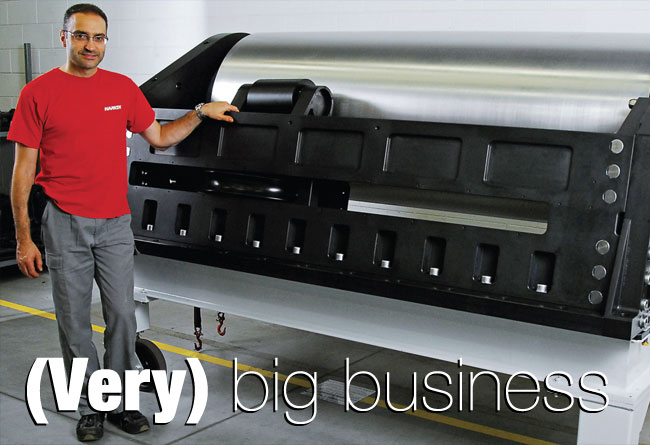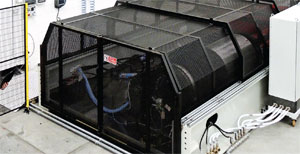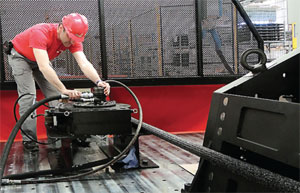

Harken is already anticipating a new generation of even larger mega-sloops with the development of its latest 70-Ton PowerReel Captive Reel winch
Until 2014, Harken offered eight sizes of Captive reel winches with maximum working loads (MWL) of 1.5 to 25 metric tons and tensioners to fit six configurations. This range of Harken winches, coupled with their innovative tensioners, already offered highly-efficient sheet-management solutions for all of today’s rope types. However, the rumours that 80 to 100 metre sloops were progressing to design stage were beginning to swirl, and we felt it inevitable that a build of unprecedented magnitude would soon be a reality. So we challenged ourselves: be ready with proven technology before the first of these designs was complete.
We set out to design, produce, and fully test a captive reel winch system with a 70-ton MWL – the most powerful ever designed for a sailing application and significantly beyond the MWLs needed so far in the market. We were incredibly excited by the opportunity presented by this large project, understanding that the financial commitment required would be a knowledge investment useful for trickling down to any lower MWL range.
DESIGN REQUIREMENTS
Test bench
Testing to and beyond the 70-ton working load that megasloops will someday generate required the completion of a 20-metre, 25,000kg steel test bench. This is now the fifth and largest of the test benches in the Harken Italy factory. The bench’s flexible platform is designed to accommodate different layouts to simulate a variety of operating conditions. Built for load tests of up to 100 tons, it also allows the addition of a pulley for deviation.
Simulating typical blue water sailing conditions on the bench demonstrates how different large diameter lines perform under long term loading. The test bench eases sheets at low and high loads at a variety of speeds and conditions. If certain sheets are highly loaded for long periods of time, their fibres stretch and stiffen, and the line becomes completely unbendable. With the correct sheet selection and our new tensioner design, Harken is able to provide high load systems that will last for many sailing years with few sheet problems.
Hydraulic and electric Captives
A major design objective for the 70-ton PowerReel Captive winch system R&D project was the creation of both hydraulic and electric power versions. Initially, the long history of hydraulics in the marine industry, plus the market’s knowledge of other onboard systems possibly similar to where we’d end up with this project, made the hydraulic system an obvious choice. But the opportunity to create an alternative and potentially greener solution with matching performance made us strive for an electric solution as well.
Following verification that our 70-ton hydraulic Captive winch reliably met the required load and speed criteria, we began the conversion of that fundamental design to an electrically-driven system. Tests proved the 70-ton electric Captive could deliver at least the same performance as the hydraulic version. We were also pleased to discover increased line control precision, noise reduction, and greater system efficiency from the electric versions. Harken is now the first to offer not only captive winches in this load range, but strong alternatives in terms of power sourcing.

Transmission
Every Harken Captive winch over 3-tons MWL features a unique twin-screw inner transmission to eliminate the tilting effect on the winch feeder under the axial load of the sheet (other manufacturers use single-screw systems). The symmetric, synchronized twin-screw system balances the axial load of the feeder and allows a very stiff, solid frame structure at a smaller size. This results in weight savings and allows the winch to perform at higher speeds and loads with minimum component deformation and wear.
The innovative patent-pending inner transmission has an added roller to download the radial load of the feeder directly onto the drum, eliminating the need for the full frame to perform that structural job. Testing proved this new system a winner, with maximum reliability and efficiency of the sheet feeder in motion under extreme loads and speed.
Tensioner
Through-deck tensioner development started from a blank sheet of paper several years earlier. We thought the classic sheave systems with radially-pressing rollers couldn’t be as effective as having the line pulled by its full surface. After analyzing known cable management systems, we applied with a simple transmission with an equalized pulling action on all surfaces of the sheet in contact with the tensioner device. These in-line and through-deck tensioners are able to handle the full MWL loads of the Captive winch they are coupled with while keeping the desired tension on the sheet under any easing-out speed requirements. This complements the winches and provides minimal wear on the sheets – even under severe working conditions.
Drum-sheet interactions
When going well beyond the scale of existing solutions (exceeding even 40-ton loads on a sailboat captive winch is indeed that case), the system component interfaces become critical factors to consider. The sheet and the drum cannot be chosen without a deep testing of the impacts on both sheet and drum under endurance conditions. The feeder pulley was designed and dimensioned in cooperation with leading rope manufactures in order to minimize the fatigue effect on the rope.
Despite the size, the drum weight is only a minor percentage of the Captive winch’s overall weight. The effect under severe load ramps is that all wraps on the drum equalize their load with small frequent movements. This interwrap, frequent-load distribution makes creating the smoothest drum surface finish possible, an important characteristic and a prime consideration when selecting the drum material. This has been proven to be a priority for sheet durability and safety.
Feeder
Despite the record loads on the feeders, Harken decided to apply the lubrication-free technology that has proven to be the best on Harken Captive winches under 20 tons. Designing twin composite nuts for the 70-ton feeder was a challenge from an engineering and production point of view, but the results paid back the effort with new knowledge of these extreme composite applications.

DEVELOPMENT AS A SYSTEM – NOT INDIVIDUAL PARTS
A systemic approach is paramount to yacht sail management. These loads demand engineering integration for maximum performance. Isolating the selection of the winch, sheet, tensioner, and diverting blocks as independent components sacrifices the synergy that a complete solution can offer. Harken is committed to developing turnkey systems that offer the best line management available.
Building complete testing facilities in Italy and the USA allows the introduction of fully-proven new products into the megayacht market. If these yachts are racing hard, Harken has tested solutions to overcome the friction and heatgeneration problems that may arise. Constant trimming in and out a few inches to play every gust while beating up a race course is normal on a 420 or an AC boat. Now it’s also imaginable on a megayacht with a 70-ton load on the sheet.
The Harken 70-ton PowerReel Captive winch project, along with the ability to drive an entire captive winch line either hydraulically or electrically, has proven successful. To complement the Captives, Harken continues to offer deck winches, cylinders, hardware, a technical team to work with the yacht’s system engineers, and trained service technicians to offer help for the life of the yacht.
Click here for more information on Harken»
We invite you to read on and find out for yourself why Seahorse is the most highly-rated source in the world for anyone who is serious about their racing.
To read on simply SIGN up NOW
Take advantage of our very best subscription offer or order a single copy of this issue of Seahorse.
Online at:
www.seahorse.co.uk/shop and use the code TECH20
Or for iPad simply download the Seahorse App at the iTunes store


